TRAC Monthly Report: November 2024
- Category: Monthly Reports
- Author: JM
- Published: 02 Dec 2024
- Last updated: 09 Dec 2024
Autumn Constellations
November offered limited opportunities for serious stargazing, but we did manage to see a few autumn constellations. While we were out observing Venus and Jupiter, we identified the following:
- Pegasus – The Winged Horse:
Everyone should be able to point to the four magnitude +2 stars that make up the "Great Square of Pegasus" and use it to find Andromeda. Look south of the square and you'll find the Circlet of Pisces asterism, and further south-west lies Neptune, our main prize! - Taurus – The Bull:
Our attention was focused on Taurus as it's home to the Pleiades and Hyades open clusters, the bright orange star Aldebaran, and this year Jupiter and Uranus can be found in Taurus. We briefly searched for the planet Uranus to the south-west of the Pleiades on 30 Nov. - Auriga – The Charioteer:
By now, we're all accustomed to seeing Auriga's brightest star, Capella. It's the sixth-brightest in the night sky.
Lunar Observations
The Full Moon Rises
At 16:00 on 15 Nov, we met in the park and looked east to watch the Full Moon rise in the twilight sky. This magical occasion was somewhat spoilt by horizontal layers of cloud. We could only fully see the moon when it passed between these cloud layers as it rose.
Despite the adverse conditions, Matey and I were able to take a reasonably clear photo (below) of the Moon at perigee.
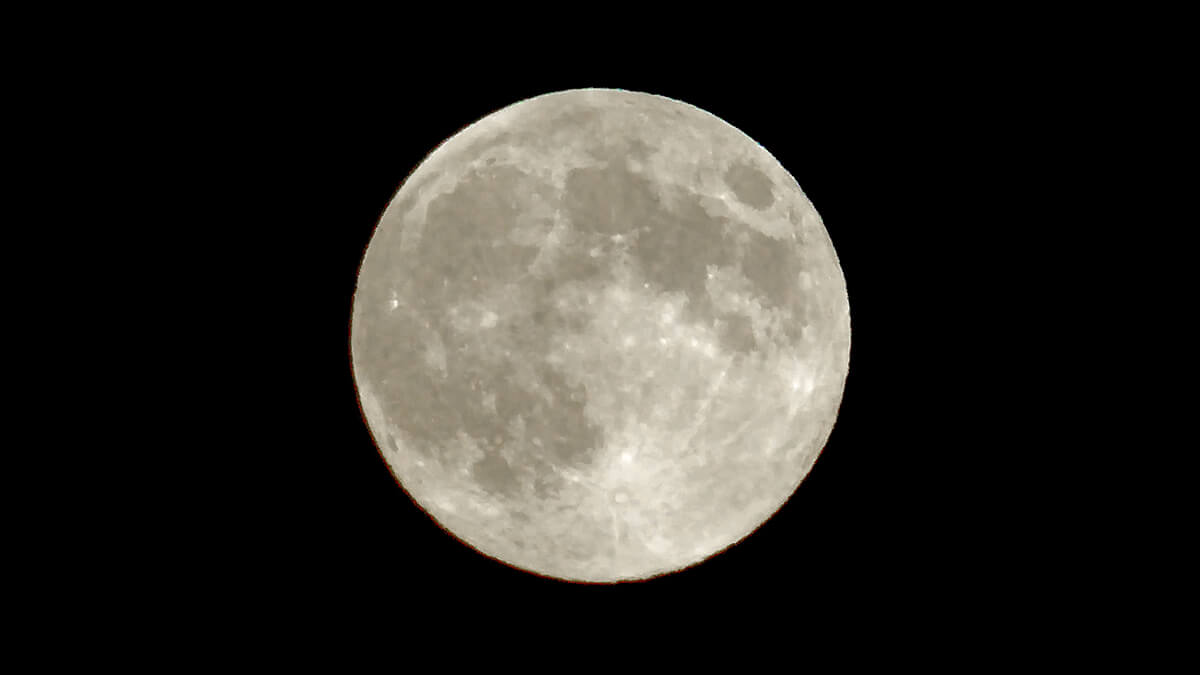
Image credit: MK/JM/TRAC
Lunar Crater Photography
On 15 Nov, TRAC team member Matey set out to take some photos of the Full Moon at perigee. The conspicuous lunar crater, Tycho, was his main focus.
Our astrophotography session was hindered by fast-moving clouds, and by 23:45, we were left with total cloud cover.
Despite the challenges, Matey successfully captured some decent photos of the Tycho crater using a Google Pixel 8. The images give the Moon a striking 3D effect, clearly showing it as a spherical object rather than a flat disc.

Image credit: MK/JM/TRAC
Tycho crater (bottom centre) at ~50x magnification. The ray system surrounding Tycho is visible, and the distinctive craters Copernicus and Kepler (top centre) are easily identifiable.
Moon-Mars Conjunction
On 20 Nov, we observed the Moon–Mars conjunction in the north-east, just about visible above the rooftops. Both the Moon and Mars were positioned close together in the constellation Cancer.
We took a few photos, but the weather conditions were rather poor, so the images were blurred. The conjunction was difficult to capture due to the brightness of the Moon. Unfortunately, the Panasonic Lumix camera is not appropriate for this type of photography.
Moon Shadow Transits
Jupiter-Io Transit
On 10 Nov, we observed our first moon shadow transit. The innermost Galilean moon, Io (mag. +5.0), passed directly between the Sun and Jupiter (mag. -2.6), casting its shadow onto Jupiter's upper cloud layers – a spectacle we observed from here in Rainham.
We even captured the event on camera. Matey took a superb photo of Io's shadow crossing Jupiter using a Google Pixel 8. The image shows Jupiter's two distinctive dark equatorial belts, and the faint dark spot near the eastern edge of the planet's southern belt is Io's shadow.
To top it off, the camera managed to pick up Europa (mag. +5.3), the smallest of the four Galilean moons – it's the faint dot to the lower left of Jupiter.
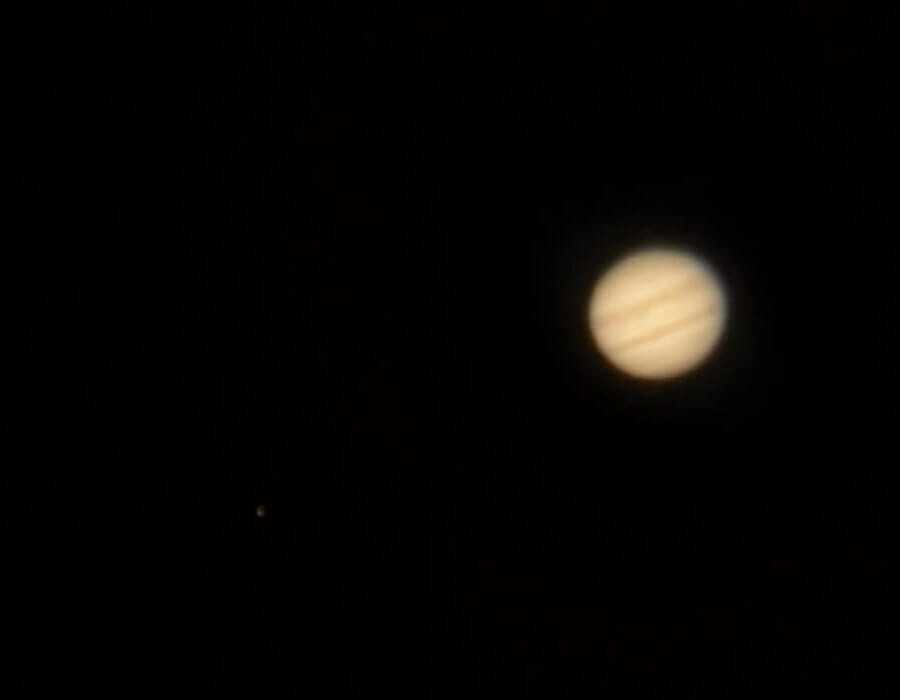
Image credit: MK/TRAC
Earlier in 2024, we tuned in to watch the USA solar eclipse from afar, but, in some sense, we can say that we've witnessed an eclipse with our own eyes this year – only this one took place on another planet, 627 million kilometres away!
This event was the highlight of the month, and Matey's photo stands a good chance of winning the coveted "TRAC Photo of the Year" award.
A second attempt to observe an Io-Jupiter shadow transit on 26 Nov ended in failure due to thick cloud cover. The weather conditions made it impossible to get a clear view of Jupiter.
Saturn-Titan Transit
On 20 Nov, Matey and I ventured out at 21:30 to catch the Saturn-Titan shadow transit, which was at its midway point. Unfortunately, the entire southern sky was covered in cloud. It was particularly frustrating for us because the sky had been clear earlier in the evening, and we were optimistic about our chances.
There'll be other opportunities in the coming months. We have two more Titan transits coming up in December 2024. Let's hope the skies are clear for at least one of those events.
Planets
Venus
At the start of November 2024, the planet Venus was high enough to be seen just above the rooftops around sunset. The photo below shows Venus grazing the roofs in the south-west.
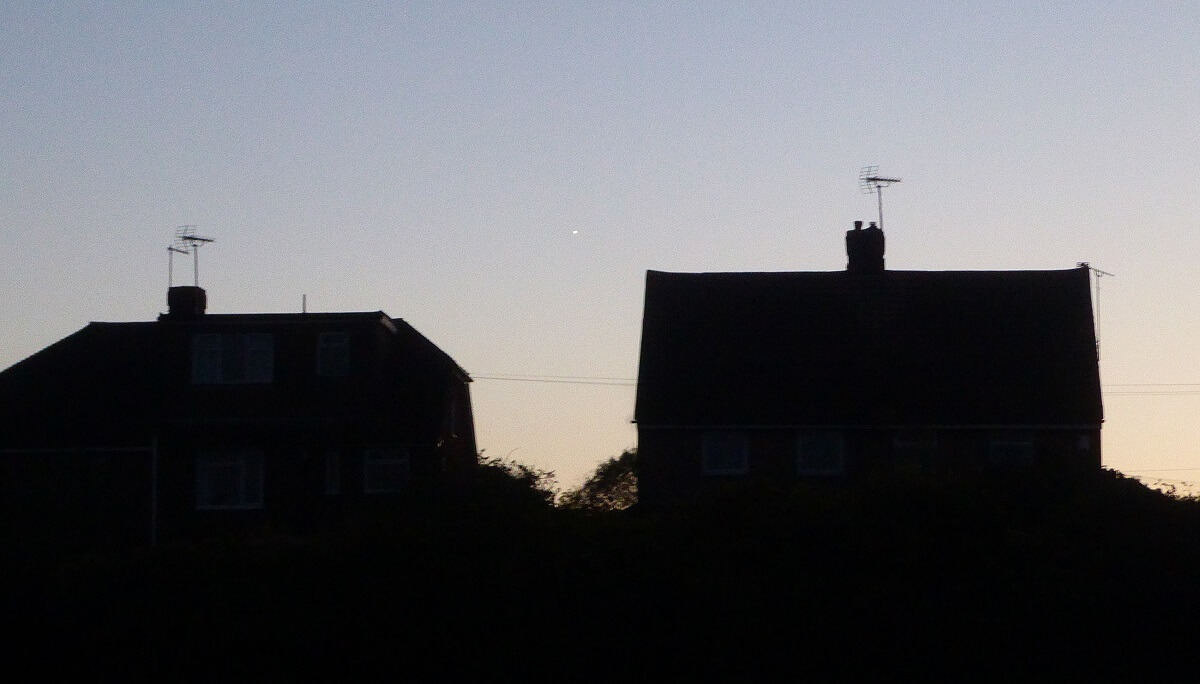
Image credit: JM/TRAC
On 20 Nov, we took the binoculars and camera equipment to the park on this very cold, clear evening. Venus (mag. -4.0) was unbelievably bright. Matey took the photo below of Venus glowing in the twilight sky above the rooftops of houses on Bettescombe Road.
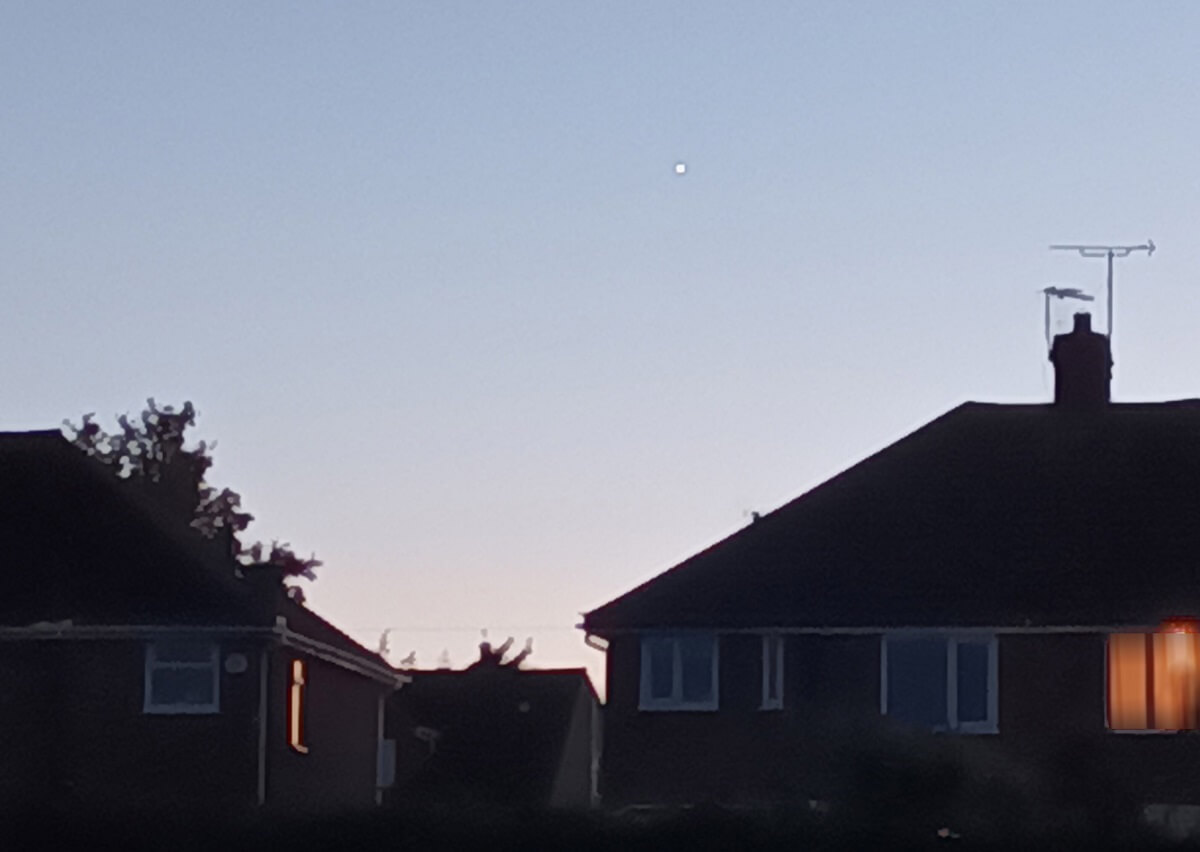
Image credit: MK/TRAC
We made our first telescopic observations of Venus on 29 Nov. Again, we were in the park looking south-west. For once the sky was perfectly clear, without a cloud in sight.
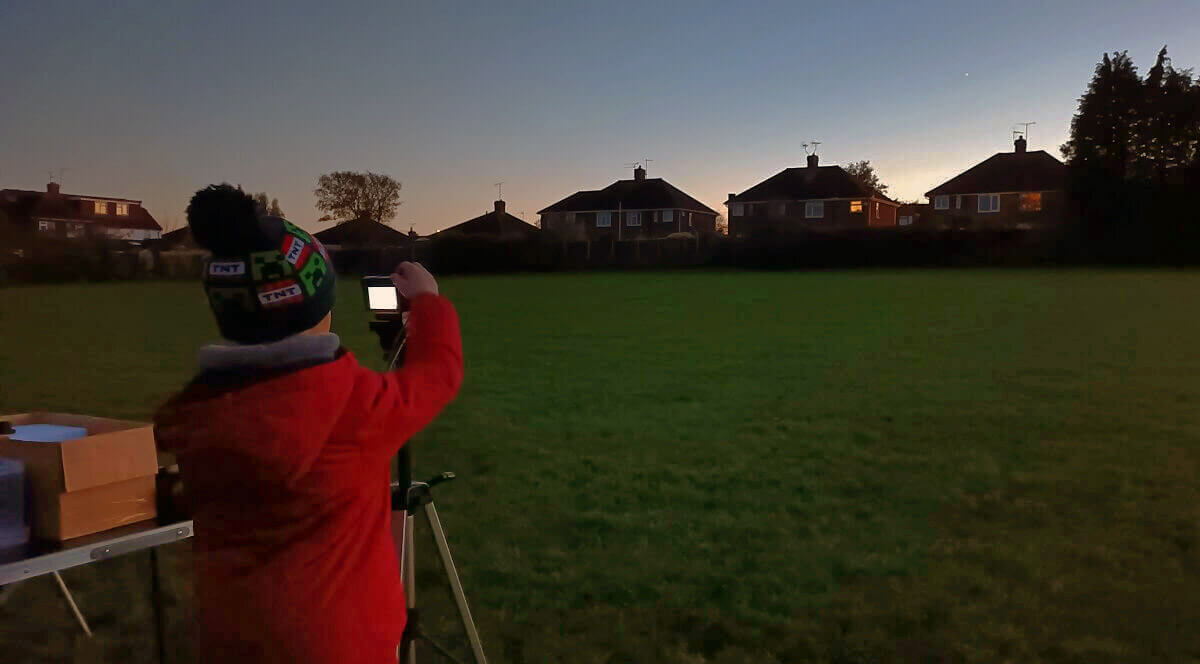
Image credit: JM/TRAC
Above image: A TRAC member skillfully photographs Venus (top right) on 29 Nov 2024.
Using the telescope with the 32mm eyepiece, Venus appeared exceptionally sharp, and we could clearly make out its 68% phase early in our observation session. Once the sky got darker, the glare from Venus was so intense that its phase was no longer discernible.
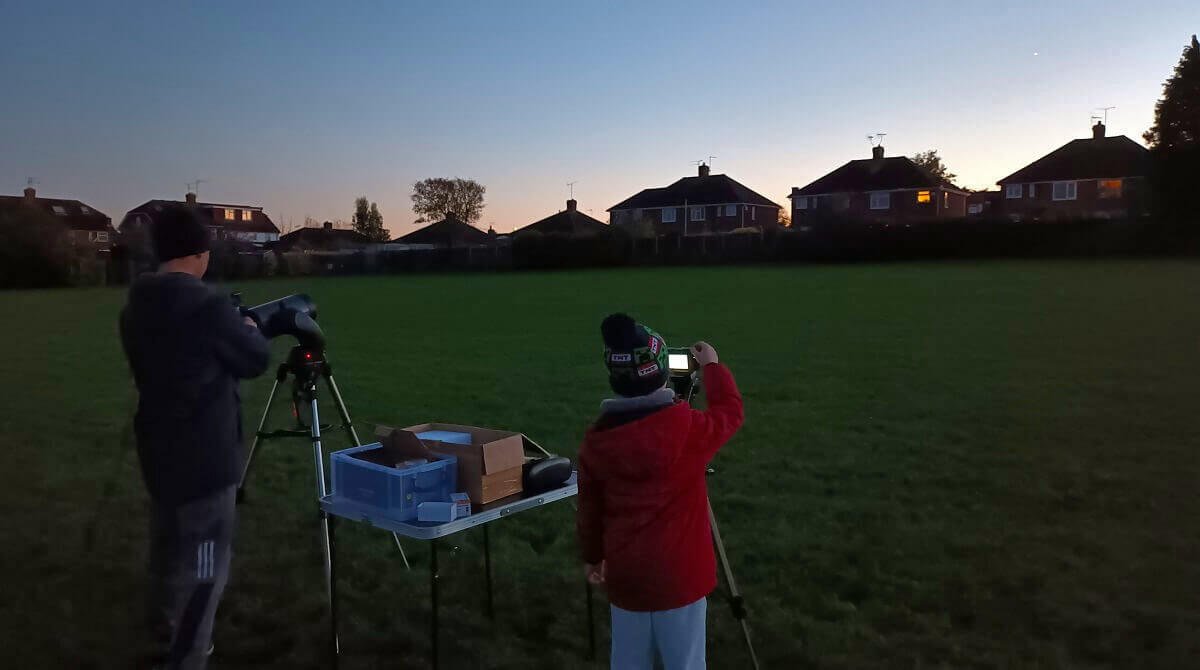
Image credit: JM/TRAC
Above image: Two TRAC members admire Venus (top right) at twilight on 29 Nov 2024.
Next time, we'll try using the zoom lens early in the twilight to see if we can get a sharper image and use the phone adapter to take some photos.
Video credit: KK/TRAC
Above video: An experimental timelapse video of Venus setting in the south. The video is 60x normal speed. It shows you how far Venus moves in 5 minutes. The other lights in the sky are aeroplanes. The tripod moved a lot due to the brisk wind blowing across the open field. Next time, we'll try to weigh it down to increase its stability.
Mars
On 15 Nov, Matey and I observed Mars (mag. -0.2) through the telescope for the first time. It appeared as a small, hazy orange disc, but unfortunately, we couldn't make out any surface details. The photo below shows roughly how Mars appeared through the telescope.
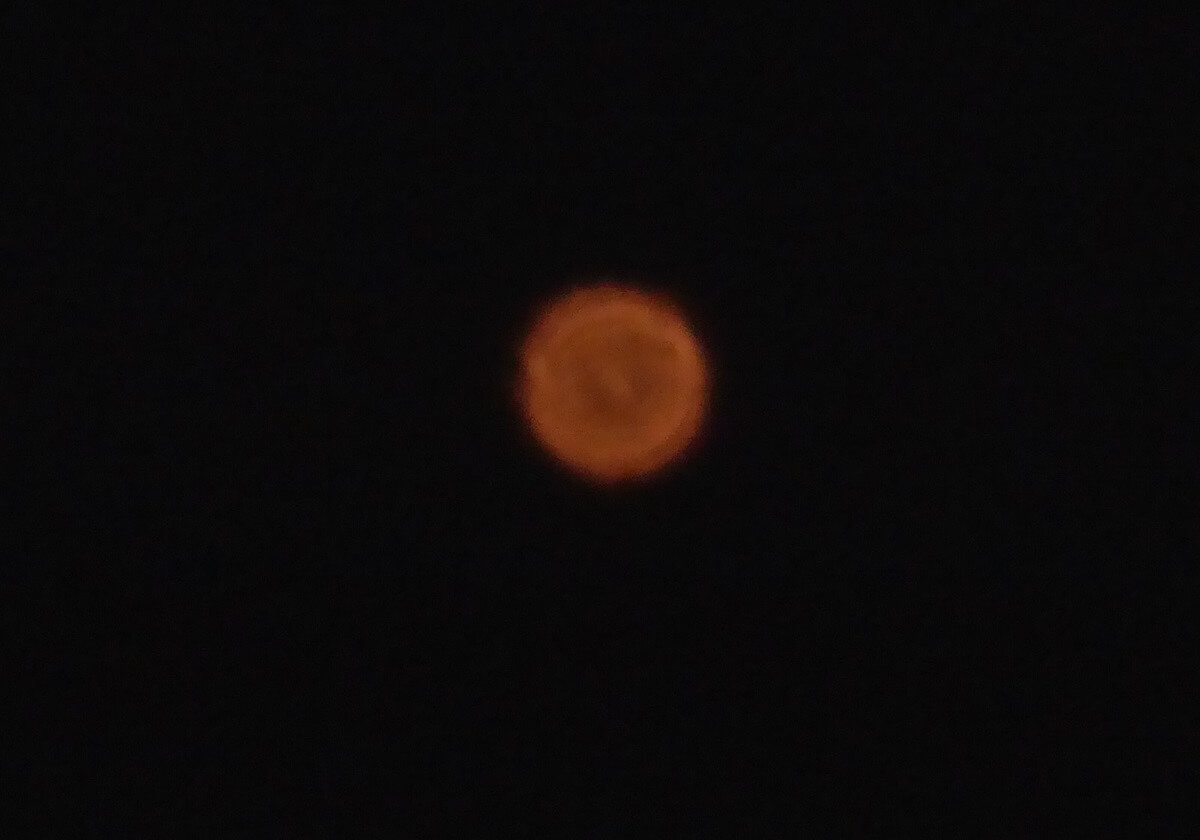
Image credit: MK/JM/TRAC
Mars is the only terrestrial planet whose surface features are visible through a small telescope like ours. Hopefully, we'll be able to see more detail on the Red Planet during future observations.
To the naked eye, Mars typically looks like a bright orange star.
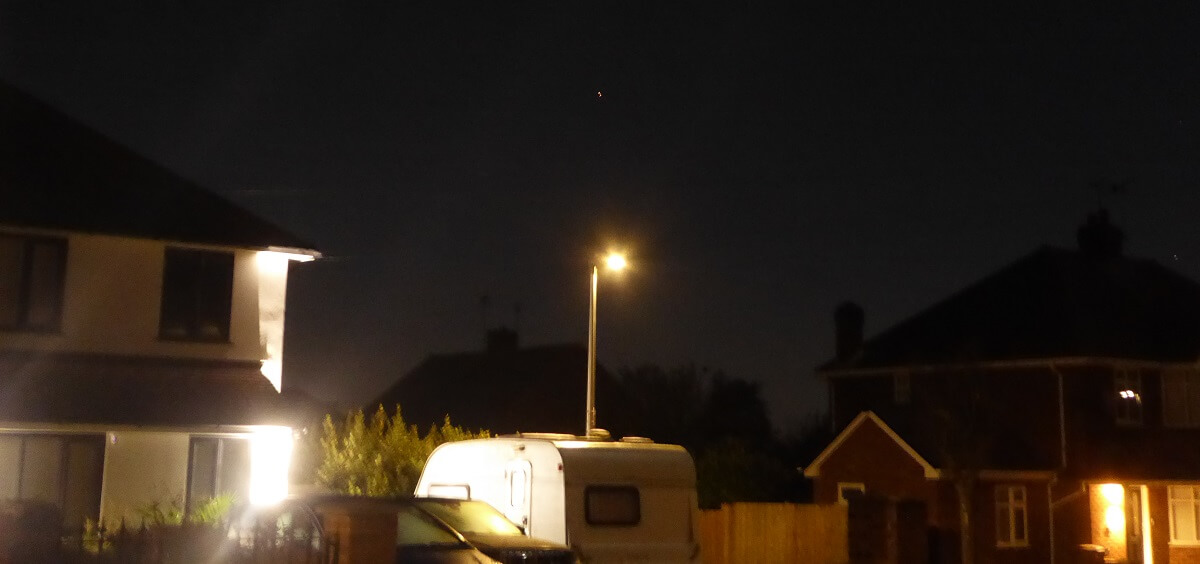
Image credit: JM/TRAC
The image above shows how Mars appeared from Taverners Road at 22:15 on 15 Nov 2024. Mars is the small reddish-orange dot directly above the streetlight.
We also observed the Moon conjunction with Mars on 20 Nov 2024.
Jupiter
Our main observation of the Jovian system took place on 10 Nov, during the Io shadow transit.
Jupiter's Great Red Spot remains to be seen. We'll aim to observe it in December when Jupiter will reach opposition. There'll be more moon shadow transits of Jupiter in December, too.
Saturn
We only took a quick look at Saturn while we were out to view Venus on 19 Nov, but the view was surprisingly clear. I thought the view of the planet's rings was about the best we've seen in the past three months.
Next time we see Saturn, we'll take some photos of its beautiful rings.
Uranus
Success! We located Uranus using binoculars on 28 Nov.
Our strategy was to find a distinctive pattern of nearby stars and use them to pinpoint the planet.
We used the Stellarium app to find some bright stars close in the vicinity of Uranus. We noticed that:
- Four stars (mag. +6.3 - mag. +7.1) forming a trapezium lie to the lower left of Uranus.
- The star HIP-16077 (mag. +6.6) was located slightly to the west of Uranus.
- A group of brighter stars (mag. +4.5 to mag. +6.1) lie to the upper right of the planet.
Using these stars as a guide, we were able to determine which object was Uranus with 100% confidence!
Now that we've observed Uranus with binoculars, our job in December will be to confirm our sighting with the telescope. While Uranus appears as a star-like point of light through binoculars, the telescope should reveal it as a tiny blue disc.
Anyone who had difficulty focusing the binoculars and holding them steady will be required to attend a daytime lesson to perfect their binocular-wielding skills. Every TRAC member needs to be able to handle a pair of binoculars like a pro.
I also need to remember to find the tripod attachment for the binoculars. Fixing them in place will allow everyone to check that we're observing the same object when using the binoculars.
Neptune
I'm very sad to report that we had few chances to search for Neptune (mag. +7.9) in November.
On 28 Nov, I attempted to find Neptune using binoculars in the park at 19:00, relying on Stellarium to determine its position. While it was relatively easy to identify the nearby constellations, the surrounding fainter stars (mag. +6.1) were only barely visible through the binoculars, and HD 223620 (mag. +8.0) was not visible at all.
I'm sure that I was looking in the correct location, but I couldn't spot Neptune. While the binoculars should have sufficient power to reveal Neptune as a faint star-like point, the conditions weren’t ideal. It likely wasn’t dark enough, and a thin layer of diffuse cloud amplified the skyglow.
I've always said that Neptune will cause us trouble! We may have underestimated just how tricky it is to observe. All we can do now is ensure we make a concerted effort to spot it on every clear night in December.
Astrophotography
Cosmic Paparazzi
Krum was very enthusiastic about photography and took many photos of Venus, Jupiter, Vega, and Capella on the evening of 29 Nov. He also created a timelapse video of Venus drifting westward and recorded the ISS as it sped high above the park.
With a lot of perseverance, Matey produced some fantastic images of the Moon and Io's transit of Jupiter in November. Some of his photos are featured in this report and on the home page.
Next Steps
In December, we need to review all of the images we've captured and upload the best ones to the website.
We have a couple of budding astrophotographers on our team! I'm sure this is an area we'll explore further in 2025.
Timelapse Looking NE
On 27 Nov 2024, Matey and Krum used a phone to record a 5-minute timelapse video as an experiment.
Video credit: MK/KK/TRAC
The camera was able to pick out several notable features in the night sky:
- The planet Mars (mag. -0.4) is the bright object to the right, steadily gaining altitude in the video.
- Four stars in the legs/feet of the large bear (Ursa Major), a few stars marking the end of the tail in Lynx, and two stars in Gemini .
- While it would be awesome if the bright trails moving left and right were meteors streaking across the sky, they are actually aeroplanes!
Team TRAC plans to take more timelapse videos and gain more experience with this photography technique in 2025.
ISS & Starlink Satellites
Evening Visitors
During the second half of November, the International Space Station (ISS) passed overhead once or twice every evening.
Throughout this period, the chain of Starlink satellites (at varying magnitudes) could also be spotted. However, they were generally faint, and their predicted paths and timings were often less reliable.
Satellite Observation Log
15 Nov:
- Starlink train (mag. +2.8) at 17:23:
No sign of the scheduled satellite train, probably due to the clouds (yet again).
21 Nov:
- ISS (mag. -3.3) at 17:22:
Clearly visible. Brightness spoilt by cloudy sky. - Starlink train (mag. +2.7) at 17:53:
On time, but barely visible due to clouds.
25 Nov:
- ISS (mag. -3.4) at 17:32:
Clearly visible. Brightness subdued by clouds. - Starlink train (mag. +2.0) at 17:20:
It was supposed to be brighter than previous trains, but it could not be seen. Probably due to cloud.
28 Nov:
- ISS (mag. -3.3) at 16:43:
Moving west to east. 90 degrees above us, following the A2 through Rainham! - Starlink train (mag. +2.5) at 17:24:
Train spotted but very dim. Not very clear or exciting this time.
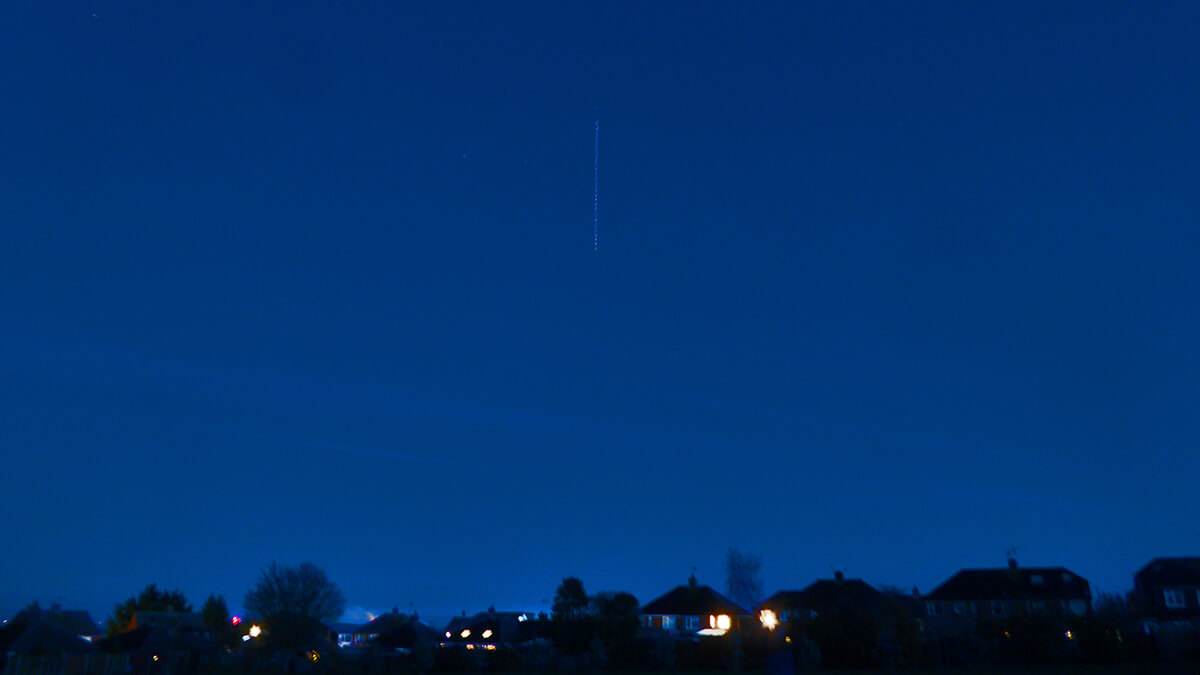
Image credit: JM/TRAC
Above image: The white vertical line in the centre is the ISS heading east over Rainham. 30 second exposure.
29 Nov:
- ISS (mag. -2.6) at 17:31:
Moved west to south-east. Max altitude: 50 degrees. Very clear sighting at dusk. - Starlink train (mag. +3.8) at 17:31:
Also W => SE at the same time as the ISS pass. Max altitude: 36 degrees. Sadly, I think it was too faint to be seen.
Video credit: KK/TRAC
Above video: Krum took this video of the ISS rising in the west and heading right overhead. The space station is the small white dot moving fast towards the upper left. To keep it in view, we had to keep moving the camera further left. That's why the ISS appears to jump around the screen a lot.
Video credit: KK/TRAC
Above video: Here the ISS is further east and is moving towards the lower left corner.
ISS in Our Sights
While watching the ISS move gracefully across the sky on November 29, I mentioned to Matey that we could try to view the space station through the telescope. Without hesitation, he pointed the telescope in the direction of the ISS and tracked it with the finderscope. Amazingly, this method worked, and we were all able to see the space station pass across the field of view!
Next time, we'll try this with a higher magnification to see if we can spot the station's large solar panels. Apparently it's possible, though very difficult to achieve. I’m confident that TRAC members will rise to the challenge!
UFOs Above Rainham
In addition to the ISS and satellite trains, many other satellites were observed crisscrossing the sky about an hour after sunset. We were unable to identify most of these satellites. It's likely that many of them were actively deployed Starlink satellites and large rocket bodies in orbit.
Telescope GoTo
We had more luck with the GoTo this month. Matey was very speedy with the sky align procedure on 29 Nov, and this time it appeared to work as expected.
Using the hand controller, Matey selected the Andromeda Galaxy, and the telescope pointed directly at it. This promising result warrants further investigation. We'll test the system again when we have an opportunity to observe Uranus.
Comet C/2023 A3 (Tsuchinshan–ATLAS)
Farewell Comet A3
We didn't see comet A3 again in November, but we never expected to!
The comet is heading away from the Sun and has faded to magnitude +9.3 by 30 Nov. Unfortunately, we won't be able to see it again. Goodbye, Comet A3 – it was an honour to meet you in October 2024!
Destination: Unknown
Media reports claim that the comet's orbital period is 80,000 years. However, in reality, it could be much longer, potentially even several million years, or it might not return to the Solar System at all! Astronomers simply do not know. It's possible that the comet could end up orbiting another star in the Milky Way.
The most experienced TRAC members know to be sceptical of hyped-up media reports, especially those making unsubstantiated claims.
Comet of the Year
As mentioned in our October 2024 Monthly Report, it's astonishingly rare to see a naked-eye comet. Comet C/2023 A3 will definitely go down as one of our highlights of 2024.
Ring Nebula and Andromeda Galaxy
We've yet to see the Ring Nebula. This might have to be one for the 2025 astronomy season.
On Nov 29, Matey successfully located the Andromeda Galaxy using the GoTo feature. Andromeda appeared as a faint patch of light through the telescope. It could clearly be identified as a galaxy, but we ought to be able to achieve a much better view under better observing conditions. Since it was only 17:15, the sky wasn't fully dark, so it wasn't the ideal time for viewing a distant galaxy.
Perhaps we'll dedicate more time to observing deep-sky objects in 2025.
Access to Ryetop Park
Medway Council has not responded to the letter we sent on 04 Oct. I sent an email directly to Medway Norse, who look after the park, on 28 Nov with our original letter and leaflet attached. Hopefully, they'll be more responsive. According to their automatic reply, we should hear from them in the next few days.
I'll keep you posted on any developments.
Summary
November 2024 turned out to be a mixed bag for the astronomy club. The poor weather during the first half of the month meant we were limited in what we could do. Despite the challenges, we ended the month on a high note with stunning views of Venus that made up for the earlier setbacks.
We had great success with Venus and the Io shadow transit. The view of Mars was a little underwhelming, but it is set to improve during December. Locating Uranus with binoculars proved that it's indeed possible to see it from Rainham. Neptune remains a huge problem for us.
We'll all need to work hard in December – it could be our time to shine!
James M
TRAC Team Leader
02 Dec 2024 – Rainham, Kent

TRAC is an amateur astronomy group based in Rainham (Kent) in the United Kingdom.
On clear nights, you'll find us outside, observing stars, planets, moons, galaxies, satellites, meteors, and comets.
This monthly report is intended to keep club members informed of our observational activities, track progress towards the club's long-term goals, celebrate successes, and record memorable moments.
Unless stated otherwise, all magnitude values refer to apparent magnitude and have usually been rounded to one decimal place.
We welcome any questions, feedback, or suggestions you may have. Please let us know if anything is unclear or if you notice an error, inaccuracy, or typo. Contact us via email.
© 2024 Taverners Road Astronomy Club